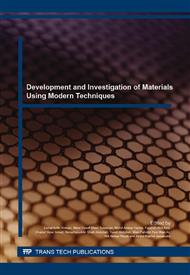[1]
C.M. Kho, A. Aziz, Z.A. Ahmad, S.K. Enche Ab Rahim, N.S. Abdullah: Initial Efforts in Modelling Mass Transport in Microdialysis Probes: Physical Characterization of the Microdialysis Probe Membrane. Adv. Mater. Res. 1087 (2015), pp.365-369.
DOI: 10.4028/www.scientific.net/amr.1087.365
Google Scholar
[2]
R.A. Saylor, S.M. Lunte: A review of microdialysis coupled to microchip electrophoresis for monitoring biological events. J. Chromatogr. A 1382 (2015), pp.48-64.
DOI: 10.1016/j.chroma.2014.12.086
Google Scholar
[3]
H. Haugaa, E.B. Thorgersen, A. Pharo, K.M. Boberg, A. Foss, P.D. Line, T. Sanengen, R. Almaas, G. Grindheim, L. Wælgaard, S.E. Pischke, T.E. Mollnes, T.I. Tønnessen: Inflammatory Markers Sampled by Microdialysis Catheters Distinguish Rejection From Ischemia in Liver Grafts. Liver Transplant. 18 (2012).
DOI: 10.1002/lt.23503
Google Scholar
[4]
S.H. Haddad, Y.M. Arabi: Critical care management of severe traumatic brain injury in adults. Scand. J. Trauma Resusc. Emerg. Med. 20 (2012), pp.1-12.
DOI: 10.1186/1757-7241-20-12
Google Scholar
[5]
P.M. Bungay, T. Wang, H. Yang, W.F. Elmquist: Utilizing transmembrane convection to enhance solute sampling and delivery by microdialysis: theory and in vitro validation. J. Membr. Sci. 348 (2010), pp.131-149.
DOI: 10.1016/j.memsci.2009.10.050
Google Scholar
[6]
N. Torto, J. Bång, S. Richardson, G.S. Nilsson GS, L. Gorton L, T. Laurell T, G. Marko-Varga: Optimal membrane choice for microdialysis sampling of oligosaccharides. J. Chromatogr. A. 806 (1998), pp.265-278.
DOI: 10.1016/s0021-9673(98)00063-6
Google Scholar
[7]
S.K. Enche Ab Rahim: Mathematical Modelling of Mass Transport in Linear, Shunt and Concentric Microdialysis Probes. Ph.D. Thesis, Universiti Malaysia Perlis.
Google Scholar
[8]
S.K. Enche Ab Rahim, M.I.H. Mohamed Dzahir, D. Arbain, N.S. Abdullah: Microdialysis technique: Overview and applications in biomedical research. Proc. International Malaysia-Ireland Joint Symposium on Engineering, Science and Business 2012 (IMIEJS 2012).
Google Scholar
[9]
N.S. Abdullah: Mathematical Modelling of Nutrient Transport in Bioreactors for Bone Tissue Growth. D. Phil. Thesis, University of Oxford.
Google Scholar
[10]
M.I. Davies, J.D. Cooper, S.S. Desmond, C.E. Lunte, S.M. Lunte: Analytical considerations for microdialysis sampling. Adv. Drug Deliv. Rev. 45 (2000), pp.169-188.
DOI: 10.1016/s0169-409x(00)00114-9
Google Scholar
[11]
A. Mehta, A.L. Zydney: Permeability and selectivity analysis for ultrafiltration membranes. J. Membr. Sci. 249 (2005), pp.245-249.
DOI: 10.1016/j.memsci.2004.09.040
Google Scholar
[12]
N.S. Abdullah, D.R. Jones, D.B. Das: Nutrient transport in bioreactors for bone tissue growth: why do hollow fibre membrane bioreactors work? Chem. Eng. Sci. 64, (2009), pp.109-125.
DOI: 10.1016/j.ces.2008.09.017
Google Scholar
[13]
J.A. Stenken, E.M. Topp, M.Z. Southard, C.E. Lunte: Examination of microdialysis sampling in a well-characterized hydrodynamic system. Anal. Chem. 65 (1993) pp.2324-2328.
DOI: 10.1021/ac00065a026
Google Scholar
[14]
W.S. Opong, A.L. Zydney: Diffusive and convective protein transport through asymmetric membranes. AIChE J. 37 (1991) pp.1497-1510.
DOI: 10.1002/aic.690371007
Google Scholar
[15]
K. Sakai: Determination of pore-size and pore-size distribution. 2. Dialysis membranes. J. Membr. Sci. 96 (1994) pp.91-130.
DOI: 10.1016/0376-7388(94)00127-8
Google Scholar
[16]
E. Nagy: Basic Equations of the Mass Transport Through a Membrane Layer (Elsevier, 2012).
Google Scholar
[17]
P. Xu, B. Yu: Developing a new form of permeability and Kozeny–Carman constant for homogeneous porous media by means of fractal geometry. Adv. Water Resour. 31 (2008), pp.74-81.
DOI: 10.1016/j.advwatres.2007.06.003
Google Scholar


